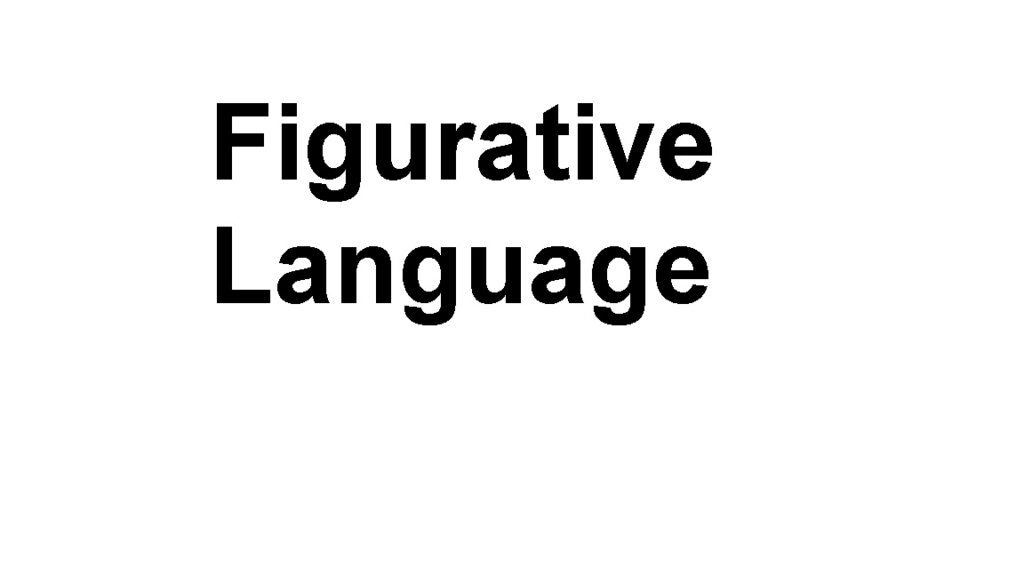What is Figurative language and how to use them in ACT, Digital SAT, EST
Figurative language refers to the use of words or expressions that deviate from their literal meaning in order to create a more vivid or imaginative description. It adds depth and richness to writing by using techniques such as similes, metaphors, personification, hyperbole, and more. Here are a few examples of different types of figurative language:
Simile: A simile is a figure of speech that compares two different things using “like” or “as.” It helps to create vivid imagery and draw connections between unrelated concepts. For example:
“He runs as fast as a cheetah.”
“Her voice is like velvet.”
Metaphor: A metaphor is similar to a simile, but it directly states that one thing is another. It suggests a comparison between two unrelated things, often using “is” or “are.” Metaphors can be poetic and evoke strong emotions. For example:
“Time is a thief.”
“The world is a canvas.”
Personification: Personification is a literary device that attributes human qualities or actions to inanimate objects, animals, or abstract concepts. It brings life and personality to non-human entities. For example:
“The wind whispered through the trees.”
“The sun smiled down on us.”
Hyperbole: Hyperbole is an exaggerated statement or claim not meant to be taken literally. It is used for emphasis, humor, or to create a strong impact. For example:
“I’m so hungry I could eat a horse.”
“I’ve been waiting here for ages!”
Alliteration: Alliteration is the repetition of the same consonant sound at the beginning of adjacent or closely connected words. It creates a musical quality and enhances the rhythm of a sentence. For example:
“Peter Piper picked a peck of pickled peppers.”
“She sells seashells by the seashore.”
Onomatopoeia: Onomatopoeia refers to words that imitate or resemble the sound they represent. They help to create a sensory experience and make writing more immersive. For example:
“The bee buzzed by my ear.”
“The thunder roared in the distance.”
Idiom: Idioms are expressions or phrases that have a figurative meaning different from their literal interpretation. They are unique to a particular language or culture and add color and depth to language. For example:
“Break a leg!” (meaning “good luck”)
“It’s raining cats and dogs.” (meaning “heavy rain”)
Symbolism: Symbolism is the use of symbols to represent ideas, qualities, or concepts. Symbols can be objects, colors, animals, or actions that carry deeper meanings beyond their literal representation. For example:
A red rose symbolizing love and passion.
A dove symbolizing peace and purity.
Irony: Irony is a contrast between what is expected and what actually happens, resulting in a humorous or sarcastic effect. It often involves a discrepancy between appearance and reality. There are different types of irony, including verbal irony (saying the opposite of what is meant), situational irony (when the outcome is different from what is expected), and dramatic irony (when the audience knows something that the characters do not). For example:
“What a beautiful day!” said sarcastically during a thunderstorm.
A fire station burning down.
Oxymoron: An oxymoron is a combination of contradictory words or ideas to create a unique effect. It highlights the contrast between two opposing concepts. For example:
“Bittersweet” (combining bitterness and sweetness).
“Jumbo shrimp” (combining large and small).
Allusion: An allusion is a brief reference to a well-known person, event, place, or work of literature. It adds depth and richness to the text by invoking associations and shared knowledge. For example:
“He was a real Romeo with the ladies” (alluding to Shakespeare’s play “Romeo and Juliet”).
“She has the wisdom of Solomon” (alluding to the biblical figure King Solomon).
Euphemism: A euphemism is a mild or indirect expression used to replace a harsh, unpleasant, or taboo word or concept. It is often used to soften the impact or make something more socially acceptable. For example:
“Passed away” instead of “died.”
“Senior citizens” instead of “elderly people.”
Synecdoche: Synecdoche is a figure of speech in which a part of something is used to represent the whole or vice versa. It creates an emphasis on a specific aspect or highlights the relationship between the part and the whole. For example:
“All hands on deck” (referring to all the crew members on a ship).
“The pen is mightier than the sword” (referring to writing as a powerful tool).
Figurative language allows writers to convey complex ideas, evoke emotions, and create memorable imagery. It adds depth and creativity to writing, making it more engaging and impactful for the reader.
Figurative Language Examples ACT, Digital SAT, EST
Simile:
“The waves crashed against the shore like thunder, shaking the ground beneath our feet.”
In this example, the simile compares the crashing waves to thunder, creating a vivid image of the powerful and forceful nature of the waves.
Metaphor:
“Her laughter was a bubbling brook, filling the air with joy.”
This metaphor compares the sound of her laughter to a bubbling brook, evoking an image of a gentle and pleasant sound.
Personification:
“The moon peeked through the clouds, casting its silver gaze upon the sleeping city.”
By personifying the moon and giving it the ability to “peek” and “cast its gaze,” the writer brings the moon to life and paints a vivid picture of its presence in the nighttime scene.
Hyperbole:
“The suitcase weighed a ton, and I struggled to lift it off the ground.”
This hyperbole exaggerates the weight of the suitcase to emphasize the difficulty and physical strain involved in lifting it, creating a vivid image of the burden.
Alliteration:
“The shimmering stars scattered across the midnight sky, shining like silver sequins.”
The alliteration of the “s” sound in “shimmering stars” and “silver sequins” creates a musical quality and enhances the visual image of the sparkling stars.
Onomatopoeia:
“The fire crackled and popped, sending sparks dancing into the night.”
The onomatopoeic words “crackled” and “popped” imitate the sounds of a fire, allowing the reader to vividly imagine the warmth and flickering light of the fire.
Symbolism:
“The withered tree stood as a testament to the passage of time and the resilience of nature.”
By symbolizing the withered tree as a testament to time and resilience, the writer creates a vivid image that conveys a deeper meaning and emotional impact.
How to use figurative language to create vivid images ACT, Digital SAT, EST
Simile:
“Her eyes sparkled like diamonds, illuminating the room with their brilliance.”
This simile compares the sparkle in her eyes to the brilliance of diamonds, creating a vivid image of radiant and captivating eyes.
Metaphor:
“The city was a bustling beehive, filled with the constant hum of activity.”
This metaphor compares the city to a beehive, emphasizing the busy and vibrant nature of urban life.
Personification:
“The sun kissed the horizon, painting the sky with hues of orange and pink.”
By personifying the sun and using the verb “kissed,” the writer creates a vivid image of the sun’s gentle and beautiful interaction with the horizon.
Hyperbole:
“The room was so silent, you could hear a pin drop.”
This hyperbole exaggerates the level of silence in the room, creating a vivid image of absolute stillness and quietness.
Alliteration:
“The wind whispered through the weeping willows, weaving a woeful melody.”
The alliteration of the “w” sound in “wind whispered,” “weeping willows,” and “woeful melody” creates a musical quality and enhances the visual and auditory imagery of the scene.
Onomatopoeia:
“The firework exploded with a bang, showering the night sky with a cascade of colorful sparks.”
The onomatopoeic word “bang” imitates the sound of the firework, while the description of the colorful sparks creates a vivid visual image.
Symbolism:
“The broken chains symbolized their liberation from oppression, a triumph of freedom.”
By using broken chains as a symbol, the writer creates a vivid image that represents the concept of liberation and freedom.
Figurative language allows writers to engage readers’ senses, emotions, and imagination, enabling them to visualize and experience the scenes, characters, and ideas being portrayed. It adds depth, beauty, and impact to the writing, making it more engaging and memorable.
examples of how writers use metaphors to convey complex ideas:
“Time is a thief.”
This metaphor suggests that time has the power to steal or take away valuable moments or opportunities. It conveys the idea that time passes quickly and can rob us of precious experiences.
“Her words were daggers.”
This metaphor implies that the impact of her words was sharp and hurtful, comparing them to the piercing and damaging effect of a dagger. It conveys the emotional pain caused by her speech.
“Love is a battlefield.”
This metaphor portrays love as a challenging and tumultuous experience, similar to a battlefield. It suggests that love involves struggle, conflict, and the need for strategic maneuvering.
“The world is a stage.”
This metaphor, famously used by William Shakespeare in his play “As You Like It,” implies that life is like a theatrical performance. It suggests that individuals play various roles and that life is filled with drama and performances.
“Hope is an anchor in the storm.”
This metaphor compares hope to an anchor, emphasizing its ability to provide stability, support, and a sense of security during difficult times. It conveys the idea that hope can help us weather the storms of life.
“Life is a journey.”
This metaphor portrays life as a voyage or adventure, suggesting that it involves movement, discovery, and personal growth. It conveys the idea that life is a continuous process of exploration and learning.
“The Internet is a vast ocean of information.”
This metaphor compares the vastness and abundance of information available on the Internet to an ocean. It conveys the idea that the Internet is expansive, deep, and filled with endless possibilities for exploration and discovery.
Metaphors allow writers to convey complex ideas by drawing comparisons between two seemingly unrelated things. They provide a fresh perspective and evoke vivid imagery, helping readers to understand and connect with abstract concepts in a more tangible and relatable way.
Find us of Facebook
practice digital SAT

